I love content.
I’ve been sat behind a laptop producing it for 10 years and have made a lot of cash for both myself and my clients solely off the back of content marketing.
In that time, I’ve seen a lot of different methods to make money from content and dozens of different content marketing business models.
The goal here is to give you a quick overview of the content formats you might want to explore and the business models that are most commonly associated with them.
Let’s kick this off with content formats.
The best content formats for making money
There is no one “best” format for content to make money or grow your business.
I think that might change in the future as AI takes over. Personally, I reckon video is going to become more important as time goes by.
Before I list content formats, I want to quickly explain that these are not the only formats you should be looking at. I’m focusing on the core content format and not the follow up or supplementary channels like email promotions.
Let’s get into it.

Written content
Includes a couple of different channels, but will most commonly be…
- Blog posts
- Email newsletters
- Social media
Video content
Again, there are a few obvious channels, but you’re looking at…
- Shorts
- Social media
- Video platforms like YouTube
Audio content
This is a little more limited. You can use audio content mainly on…
- Podcasts
- Video sites
There isn’t any one of these that’s “the best”.
The best is very subjective and down to you as an individual. Want you want to do is focus on the channel and format that’s most comfortable and easy to produce for you.
Making money with a content marketing business model is all about staying consistent.
So, find the channel that you can create for on a daily basis and focus your efforts there.
Now let’s get into the basis of the business model for content.
The fundamentals of making money with content
Marketing is a game of attention and trust.
You’ve got to grab attention, then build trust.
Do both of these well and asking for the sale will be a lot easier.
As mentioned in another piece on content marketing, you can build trust and get good results from content marketing by focusing on user problems.
Create content that sovles those problems to build some trust and get the right kind of attention. Do it frequently to stack that trust and make the sale easy.
You then need to sandwich your piece of content.
On one side, it’s about driving traffic to the content. On the other, pushing for sales.
The basic flow looks like this.
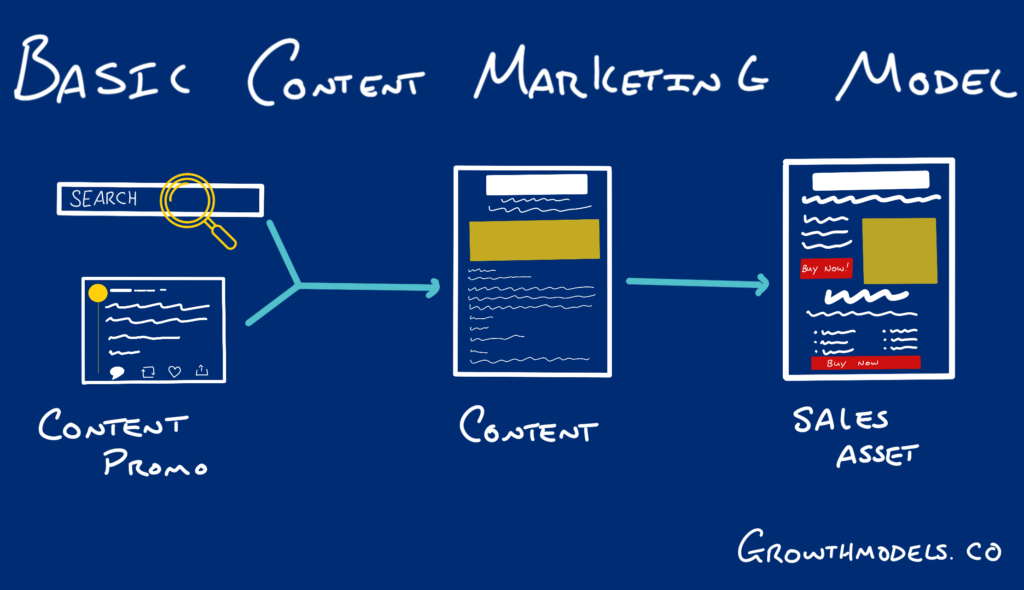
If I summarise it here for you in words it’s…
- Promote your content to interested people
- Use the content to build trust and redirect users
- Make a sale
It doesn’t matter what format of content you’re using, this is the basic flow you’ll always be using.
You might need one piece of content to get the sale, maybe 2, maybe more.
There’s no hard and fast rule for this. But the more quality content you produce, the more you increase your chances.
Now let’s look at the 3 key ways to monetise your content.
3 key methods to monetising content
There really are only 3 ways to effectively monetise content. I’ve listed them below with the pros and cons for each.
1. Monetising attention
The first is monetising attention or eyeballs.
basically, you sell exposure to the people who read your content to people who have a product or service that could benefit your audience.
This is most often going to be in the form of…
- Display ads
- Sponsorships
You’ll have seen these in action. They usually show up as something like the below.

Now for the good and bad of monetising eyeballs.
The good of selling ad space
- Easy to implement
- Very few rules and regulations
- Low chance of failure
The bad of selling ad space
- Requires a lot of traffic to make decent money
- You’re at the mercy of ad networks etc and social and search algorithms
Personally, I don’t like ads as a monetisation method. The payouts are low and you have to constantly stay on top of things outside of your control.
2. Selling other people’s products
If you have traffic, you can look at selling other people’s products for a sales commission.
This is basic affiliate marketing.
If you’re good at finding an underserved niche and can produce really useful content, you can make a lot of money this way.
You’ll have seen these kind of promotions in ac tion. they usually are on pages for things like “best microwaves”. You’ll see a list of products and links to buy them now.
Those creators are getting paid if anyone buys from their link.
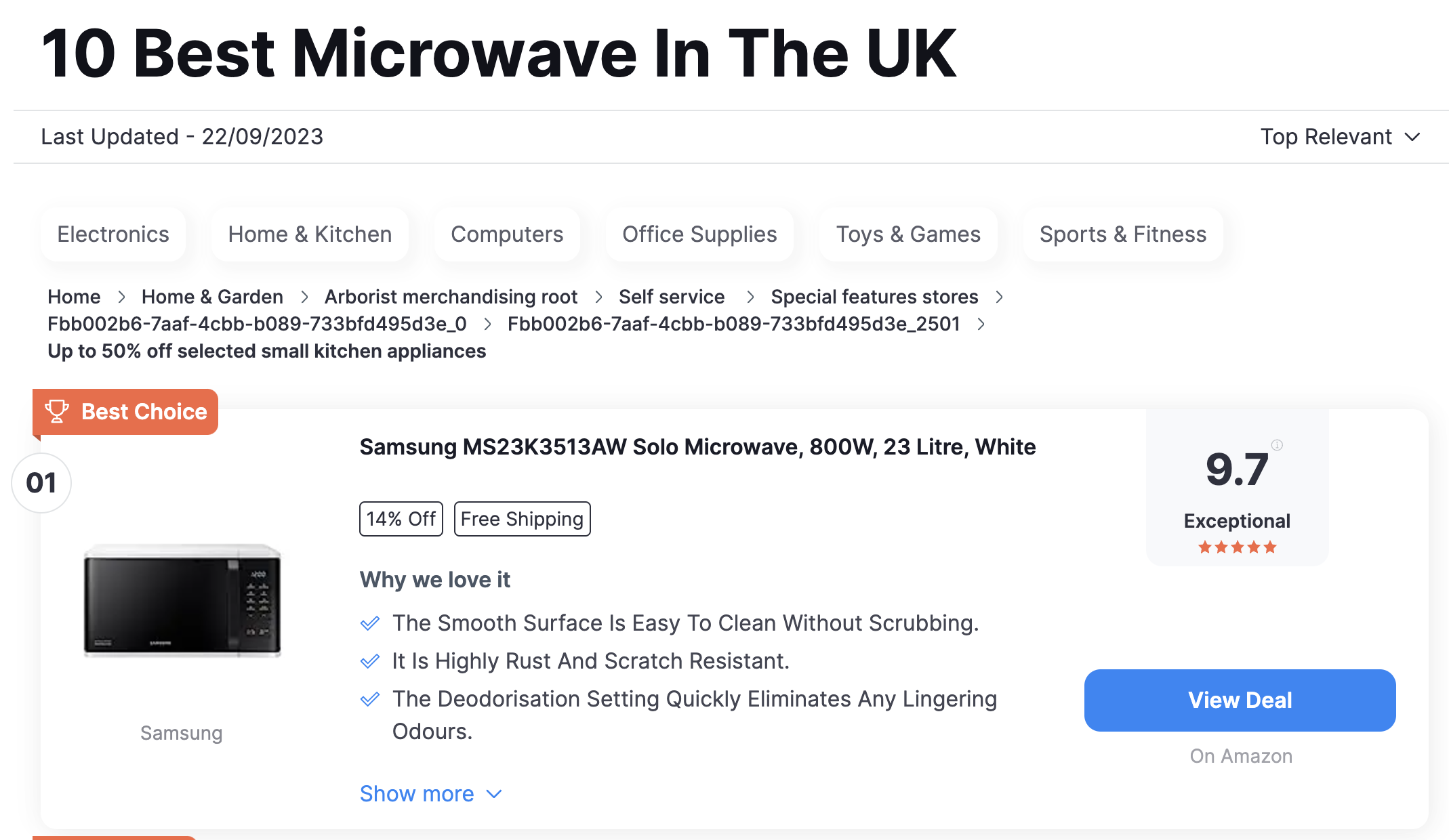
There are pros and cons to this method.
The good of affiliate marketing
- If you do it well, it can be very lucrative
- A lot of established affiliate programs to choose from
- Most niches are viable and have some form of affiliate offers available
The bad of affiliate marketing
- You’re at the mercy of social and search algorithms. If traffic drops, so do your earnings
- Very competitive and some of the best SEOs in the world are competing for the big money terms
- You own the relationship, but not the products. Affiliates can change deal structure and lower your payments whenever they want.
Let’s look at the final method.
3. Selling your own products/offers
This is my personal favourite.
You generate traffic through content marketing, and instead of getting paid a few cents for every 1000 views, or a small percentage of a potential sale, you sell your own products directly to that traffic for 100% of the money.
It’s harder as you also need to have an offer people find valuable. But, if you do, this is the best option as you then own and control the entire relationship.
I do this myself.
You’ll see that some of my articles lead to my consulting offers where people pay for my expertise. Others point to courses.
Below you can opt-in for a free training on content marketing which then leads to a program I created.
If you buy, I retain 100% of the money you pay.
There is, of course, good and bad for this as well though.
The good of selling your own services
- You retain 100% of the money you make
- You control the entire customer journey and relationship
- You can amend pricing to best fit your needs
The bad of selling your own products or services
- You also have to create and manage the product and everything that comes with it (refund requests etc)
- traffic is still at the mercy of social and search algos
In an ideal world, you’d have a couple of these running at any one time. I do just to secure myself.
I sell my own products and services and have affiliate links throughout the site.
This way, I’m more secure than just relying on one.
Let’s look at a couple of potential business models and archetypes to making money through content marketing.
Popular content marketing business models (or how to make money with content marketing)
I debated on the best way to organise this, but I think the best way is to pull real world archetypes and explain how they work and what they can do.
Realistically, you can mix and match between all of these.
If you can get attention, you can then make money with any monetisation method. However, there are some which seem better fitted to certain approaches.
1. The social influencer
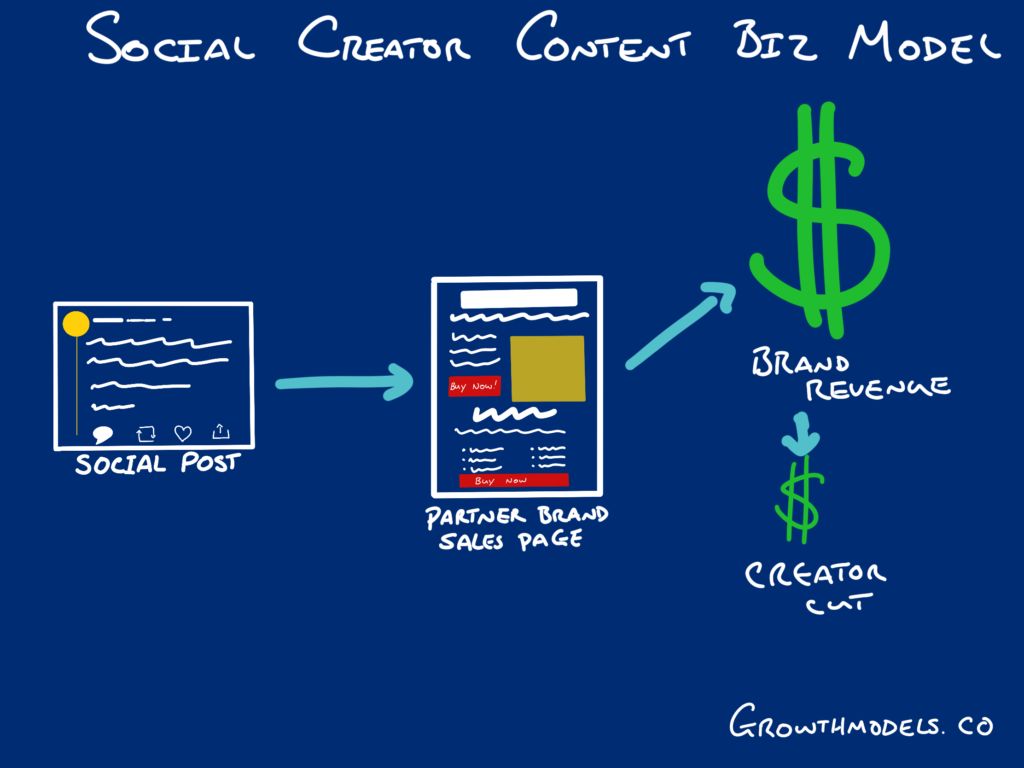
Preferred channels: Social media
You know these people. They’re the ones who can quickly generate a large social following and get people to engage with their posts.
They rely on eyeballs on their posts to make money.
They often sell little of their own and rely on brand deals and affiliate commissions to make a buck.
The risks
- You’re building on rented ground. If the social algos no longer push your reach, you’re kinda screwed.
- You’re relying on low-payout affiliate programs
- You have to constantly be churning out content else the algo will stop sending you engagements
- You need a huge audience to make decent money here.
The reward
- Zero barrier to entry
- Anyone can set up an account
Overall thoughts
I don’t like this model.
I don’t like relying so much on social media companies and hoping that they continue to allow me to make money.
For example, if you have a huge Insta following but are then banned from the platform, you’re screwed and all of your hard work is wasted.
2. The service provider
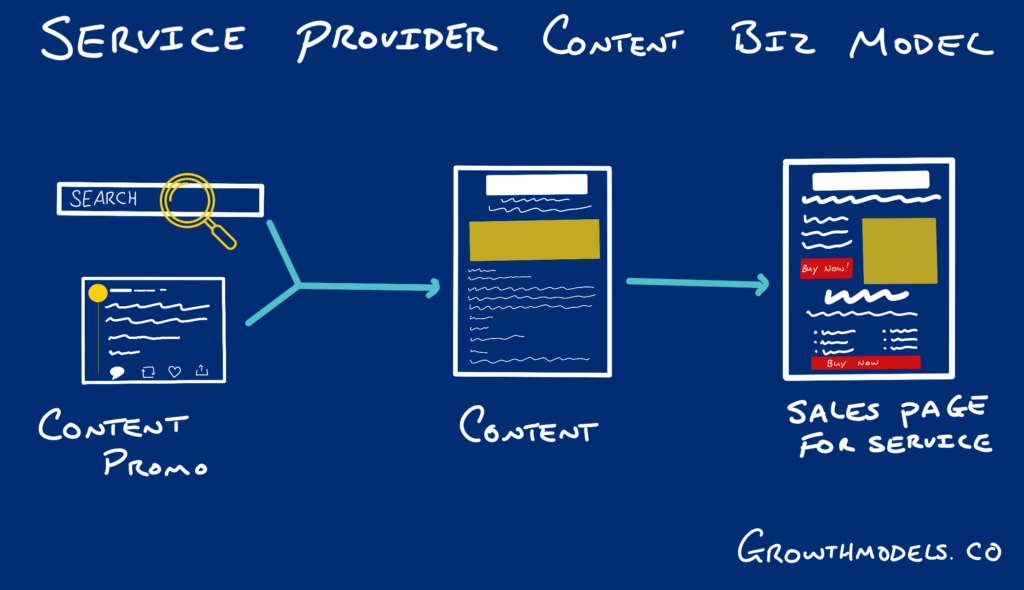
Preferred channels: Blog, YouTube for core content. Social media for promotion.
With this model, you’re looking at using long-form content on a platform you own (like your blog) to show expertise.
You’re then funneling the people who find that content into some form of nurture funnel – or even direct to a purchase page – to buy into your service.
This would usually be used by agencies, service providers (from plumbers to outsources IT help), freelancers, coaches, and consultants.
Social media would be in the mix, but not as a core store of value. rather as a promotional channel to drive more traffic to their owned assets on their website.
The risks
- A lot of the traffic gained will not be a good fit or ready-to-buy
- It can take a while for the organic content to kick in (but manual promotion can help in the meantime)
- You have to have a good product/offer else no one will buy
- Limited in how many clients you can help by your time / your team’s time
The rewards
- Usually works well to sell high-ticket offers ($2000+)
- Compounding as each new piece builds trust and reach
- You retain full monetary gain
- Usually quite scalable
3. The course creator
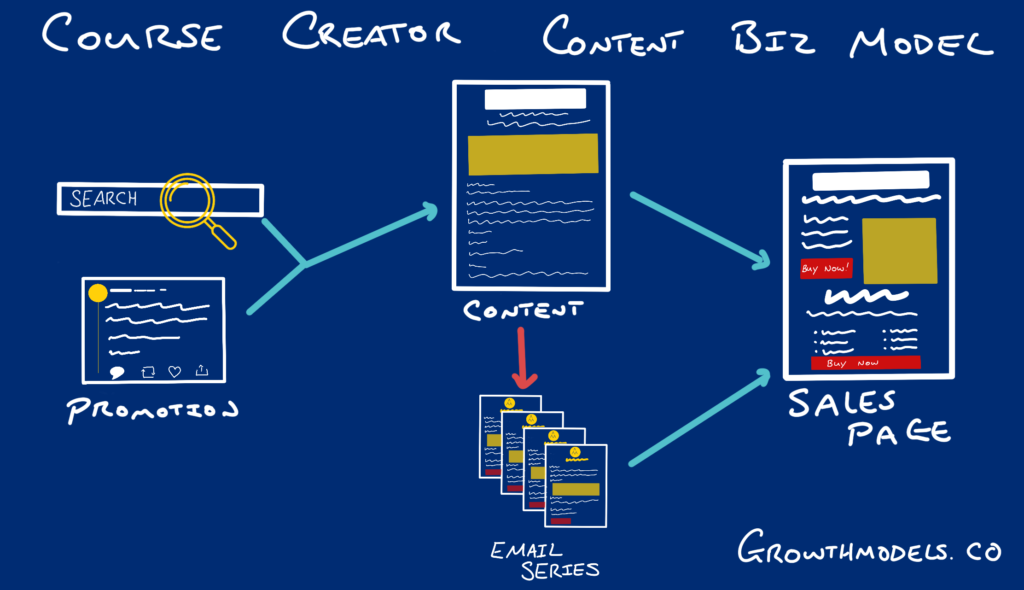
Preferred channels: Blog, YouTube for core content. Social media for promotion.
This is similar to the above.
You’re basically producing content to show expertise and then try to get users to purchase a course on the topic.
the content brings users in and builds trust. You then move those people to a sales or nurture asset to get them to open their wallets.
In effect, the core of this model is the same, the difference is in how the value is delivered after the purchase.
once someone has purchased, you’re just offering basic support for the program rather than the daily checking or client work that’s common with service offers.
The risks
- A lot of the traffic gained will not be a good fit or ready to buy
- It can take a while for the organic content to kick in (but manual promotion can help in the meantime)
- You have to have a good product/offer else no one will buy
The rewards
- Usually works well to sell high-ticket offers ($2000+)
- Compounding as each new piece builds trust and reach
- You retain full monetary gain
- Very scalable as it’s not tied to your time
4. The affiliate marketer

Preferred channels: Blog, YouTube for core content. Social media for promotion.
This is one of the models that (IMO) seems to be getting a lot of love right now. Maybe because AI content is helping people churn out blog posts.
You might also see this referred to as a “niche site”.
Same difference really.
You basically build a website that covers a specific topic in depth. Optmise the content for visibility and click-throughs. Before long, you should have a website where you’re able to sell other people’s products for a percentage commission.
A lot of the people who di this well will produce a lot of product review and comparison content to help people who are almost ready to make a purchase make a better decision on what to buy.
The risks
- Relying on search algorithms to be kind to you
- Relying on affiliate partners to not change terms
- Can require a lot of traffic
- When you do well, others will copy you
The rewards
- Can be relatively passive income
- Can scale well
- Can be a launchpad for you to offer your own product for even more revenue
5. Newsletter creator
Preferred channels: Newsletter. Social media for promotion.
This is another big one at the minute.
Newsletters have grown in popularity after the success of Morning Brew and The Hustle.
They come in many forms but it’s basically sharing expert opinion, insights, or curated news on a specific topic.
The cretaor, after gaining an audience, then generates money by selling sponsorship spaces on their newsletter.It can be a lot of work, and a lot of these never make it to the big time. But if you do, they can be quite profitable.
The risks
- Need to be able to get people to subscribe
- Requires a lot of input to do well
- A lot of competition right now
- Requires a lot of engaged and active subs to make good money
The rewards
- You own the audience relationship
- Can be sold quite easily if you get it big enough as there’s a lot of interest in “buying an audience” right now
Summing up
So, in short, there you have it.
A good overview of what you need to consider with content marketing business models.
With this knowledge, you should be able to understand what kind of approach is best for you and which channels you should be focusing on.
Remember, pick something you can do easily and consistently, other wise you’ll fail.
